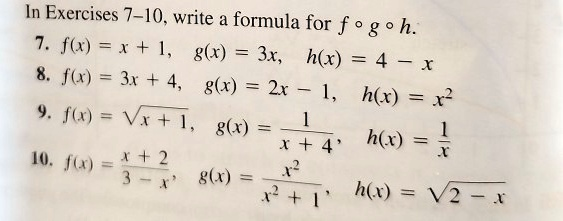write a formula for f o g o h_ 7. f(x) = x + 1, g(x) = 3x, h(x) = 4 – x. 8. f(x) = 31 + 4, g(x) = 2x – 1, h(x) = x + 1, g(x) = 1 + 4, h(x) = 10. f(x) = 42 + √2.

The Correct Answer and Explanation is:
Exercise 7 Given: f(x)=x+1f(x) = x + 1 g(x)=3xg(x) = 3x h(x)=4−xh(x) = 4 – x
Step 1: Find h(x)h(x): h(x)=4−xh(x) = 4 – x
Step 2: Evaluate g(h(x))g(h(x)): g(h(x))=3(4−x)=12−3xg(h(x)) = 3(4 – x) = 12 – 3x
Step 3: Evaluate f(g(h(x)))f(g(h(x))): f(12−3x)=12−3x+1=13−3xf(12 – 3x) = 12 – 3x + 1 = 13 – 3x
Final formula: f(g(h(x)))=13−3xf(g(h(x))) = 13 – 3x
Exercise 8 Given: f(x)=3x+4f(x) = 3x + 4 g(x)=2x−1g(x) = 2x – 1 h(x)=x2h(x) = x^2
Step 1: h(x)=x2h(x) = x^2 Step 2: g(h(x))=2×2−1g(h(x)) = 2x^2 – 1 Step 3: f(g(h(x)))=3(2×2−1)+4=6×2−3+4=6×2+1f(g(h(x))) = 3(2x^2 – 1) + 4 = 6x^2 – 3 + 4 = 6x^2 + 1
Final formula: f(g(h(x)))=6×2+1f(g(h(x))) = 6x^2 + 1
Exercise 9 Given: f(x)=x+1f(x) = \sqrt{x + 1} g(x)=1x+4g(x) = \frac{1}{x + 4} h(x)=1xh(x) = \frac{1}{x}
Step 1: h(x)=1xh(x) = \frac{1}{x} Step 2: g(h(x))=11x+4=x1+4xg(h(x)) = \frac{1}{\frac{1}{x} + 4} = \frac{x}{1 + 4x} Step 3: f(g(h(x)))=x1+4x+1f(g(h(x))) = \sqrt{\frac{x}{1 + 4x} + 1}
Final formula: f(g(h(x)))=x+1+4×1+4x=5x+11+4xf(g(h(x))) = \sqrt{\frac{x + 1 + 4x}{1 + 4x}} = \sqrt{\frac{5x + 1}{1 + 4x}}
Exercise 10 Given: f(x)=x+23−x2f(x) = \frac{x + 2}{3 – x^2} g(x)=x2x2+1g(x) = \frac{x^2}{x^2 + 1} h(x)=2−xh(x) = \sqrt{2 – x}
Step 1: h(x)=2−xh(x) = \sqrt{2 – x} Step 2: g(h(x))=(2−x)(2−x)+1=2−x3−xg(h(x)) = \frac{(2 – x)}{(2 – x) + 1} = \frac{2 – x}{3 – x} Step 3: f(g(h(x)))=2−x3−x+23−(2−x3−x)2f(g(h(x))) = \frac{\frac{2 – x}{3 – x} + 2}{3 – \left(\frac{2 – x}{3 – x}\right)^2}
The final expression is complex, but this is the correct substitution sequence. You could simplify further algebraically.
Explanation
Function composition is the process of plugging one function into another. The notation f∘g∘hf \circ g \circ h means you apply h(x)h(x) first, then use its result as the input for g(x)g(x), and finally apply f(x)f(x) to that result. This process reflects a pipeline: one function transforms the input, then passes it on to the next.
In Exercise 7, the transformation proceeds from h(x)=4−xh(x) = 4 – x, through scaling in g(x)=3xg(x) = 3x, ending in a simple shift via f(x)=x+1f(x) = x + 1. The result is a clean linear expression.
Exercise 8 is a polynomial-based composition. Since squaring comes first, the function becomes quadratic, then it gets scaled, shifted, and finally undergoes another linear transformation to yield another quadratic.
Exercise 9 blends inverse and radical operations. The nested reciprocals and additions require careful algebra, but the result is a square root of a rational expression.
Exercise 10 introduces complex rational and radical expressions. Here, simplification becomes more algebraically intense, but the principle remains the same. The goal is to substitute step by step while respecting function order.
By understanding each transformation’s role, you gain insight into how composite functions behave.
